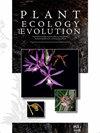刚果盆地林下木本树种叶片特征在60年期间发生了变化
IF 1.3
4区 生物学
Q3 PLANT SCIENCES
引用次数: 0
摘要
背景和目的-虽然热带森林在固碳方面发挥着重要作用,但它们被认为对气温上升和长期干旱很敏感。植物功能性状对了解和预测这些变化对植物群落的影响具有重要意义。本文以植物标本室为工具,分析了刚果盆地热带雨林60年来林下木本物种叶片特征的变化,并验证了这种变化是否与近期气候变化有关。材料和方法:2019-2022年,在刚果(金)原生林(Yangambi生物圈保护区)中,从灌木的不同位置采集了5种灌木的叶子。这些叶子与1960年以前在同一地区收集的植物标本室标本进行了比较。在这两个时期,我们评估了所有物种的叶片大小、比叶面积、气孔大小和气孔密度。林下木本物种功能性状的变异与叶片在树冠中的位置无关。这样就可以利用历史植物标本馆的资料对热带林下灌木进行性状分析。新采叶片的性状与1960年以前的标本馆叶片有显著差异:新采叶片明显较大,比叶面积较大,气孔孔长较小,气孔密度除咖啡外均较低。结论:这些特征随时间的差异可能与气温升高和大气co2浓度有关,因为近60年来杨甘壁地区的平均气温呈上升趋势,与全球CO 2水平的增加一致,而年平均降雨量保持不变。我们的研究结果首次揭示了刚果盆地森林物种对气候变化的反应,以及当温度进一步升高时,林下物种和生态系统将如何长期反应。本文章由计算机程序翻译,如有差异,请以英文原文为准。
Leaf traits of understory woody species in the Congo Basin forests changed over a 60-year period
Background and aims – While tropical forests play an important role in carbon sequestration, they are assumed to be sensitive to rising temperatures and prolonged drought. Plant functional traits are useful for understanding and predicting the effects of such changes in plant communities. Here, we analyse the variation of leaf traits of understory woody species of the Congo Basin rainforests over a 60-year period using herbaria as tools and we verify if this variation is potentially related to recent climate change. Material and methods – Leaves of five shrub species were collected in 2019–2022 in Congolese old-growth forests (Yangambi Biosphere Reserve, DR Congo) from different positions on the shrub. These leaves were compared with herbarium specimens collected in the same area before 1960. For both periods, we assessed leaf size, specific leaf area, stomatal size, and stomatal density for all species. Key results – The variability of the functional traits of the understory woody species are independent of the position of the leaves in the crown. This allows for the use of historic herbarium collections for trait analyses on tropical understory shrubs. The traits of the recently collected leaves were notably different from the traits of herbarium leaves collected in pre-1960: recent leaves were significantly larger, had a higher Specific Leaf Area, a smaller stomata pore length, and, apart from Coffea canephora , showed a lower stomatal density. Conclusion – The difference in traits over time is probably related to the increase in temperature and to atmospheric CO 2 concentration, as the average temperature at Yangambi over the past 60 years has shown an upward trend consistent with global increasing CO 2 levels, while the average annual rainfall has remained unchanged. Our results provide a first insight into the response of forest species to climate change in the Congo Basin forests, and on how the understory species and the ecosystem will react in the long term, when the temperature further increases.
求助全文
通过发布文献求助,成功后即可免费获取论文全文。
去求助
来源期刊

Plant Ecology and Evolution
PLANT SCIENCES-
CiteScore
2.20
自引率
9.10%
发文量
27
审稿时长
>12 weeks
期刊介绍:
Plant Ecology and Evolution is an international peer-reviewed journal devoted to ecology, phylogenetics and systematics of all ‘plant’ groups in the traditional sense (including algae, cyanobacteria, fungi, myxomycetes), also covering related fields.
The journal is published by Meise Botanic Garden and the Royal Botanical Society of Belgium.
 求助内容:
求助内容: 应助结果提醒方式:
应助结果提醒方式:


